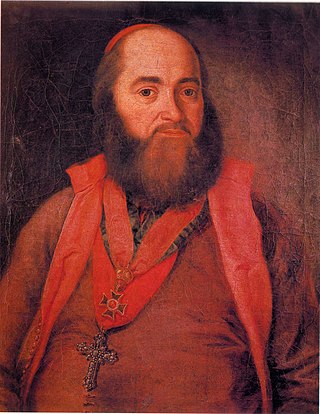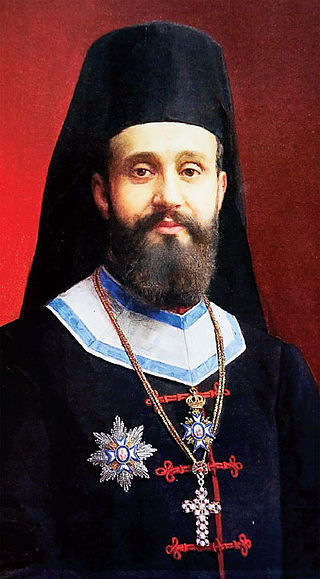
The Metropolitanate of Karlovci was a metropolitanate of the Eastern Orthodox Church that existed in the Habsburg monarchy between 1708 and 1848. Between 1708 and 1713, it was known as the Metropolitanate of Krušedol, and between 1713 and 1848, as the Metropolitanate of Karlovci. In 1848, it was elevated to the Patriarchate of Karlovci, which existed until 1920, when it was merged with the Metropolitanate of Belgrade and other Eastern Orthodox jurisdictions in the newly established Kingdom of Serbs, Croats and Slovenes to form the Serbian Orthodox Church.

Vikentije (II) was the fourth partriach of the reunified Serbian Orthodox Church, from 1950 until his death.

Stefan Stanković was a Serbian Orthodox bishop from the Eparchy of Buda and Metropolitan of Karlovci from 1836 to 1841, succeeding Stefan Stratimirović. He was succeeded by Metropolitan Josif Rajačić.

Mojsije Putnik (1728–1790) was the Metropolitan of Sremski Karlovci between 1781 and 1790, during the reign of Joseph II. He was known for publishing the Toleranzpatent meant to ensure equal rights for the Serbian Orthodox Church and the Catholic church in Sremski Karlovci.

The Metropolitanate of Zagreb and Ljubljana is an Eastern Orthodox eparchy (diocese) and one of the five honorary metropolitanates of the Serbian Orthodox Church. The headquarters of the metropolia is located in Zagreb, Croatia, and its jurisdiction covers northern Croatia and the entire territory of Slovenia.

The Eparchy of Buda is a diocese or eparchy of the Serbian Orthodox Church, having jurisdiction over the territory of Hungary. The seat of the eparchy is in Szentendre near Budapest.

Lukijan Bogdanović was the last Orthodox Patriarch of the Patriarchate of Karlovci and Metropolitanate of Karlovci. He was assassinated and decapitated while walking alone along a river bank in Bad Gastein. He was a prominent benefactor and member of Privrednik.

German Anđelić was the Patriarch of Karlovci, the spiritual leader of Habsburg Serbs, from 1881 until his death in 1888.

Samuilo Maširević was the Patriarch of Karlovci, the spiritual leader of Habsburg Serbs, from 1864 until his death in 1870.

Petar Jovanović was the Metropolitan of Belgrade, head of the Serbian Orthodox Church in the Principality of Serbia from 1833 until 1859.

Vićentije Jovanović Vidak was the Metropolitan of the Metropolitanate of Karlovci from 1774 to 1780.
Sofronije Podgoričanin was a Serbian Orthodox bishop who served in the Eparchy of Slavonia from 1705 to 1710 and was elevated to the Metropolitan of Krušedol from 1710 to 1711.
Isaija II (Antonović), also referred to Isaija II, was the eight metropolitan of Karlovci from 1748 until his death in 1749, a significant year for the Serb minority in the Habsburg monarchy. It was a time when the Serbian metropolitan and his subordinates were petitioning Maria Theresa to allow their immigrants from Venetian and Turkish lands to settle, have priests and build churches in the empire.
Evgenije Letica was a Serbian theologian, Metropolitan of the Eparchy of Banja Luka (1900–1907) and Metropolitan of Dabar-Bosna (1907–1920).
Grigorije Živković was a bishop of the Serbian Orthodox Church.

Teofan Živković also spelled Theophan Živković was the Bishop of the Serbian Orthodox Eparchy of Gornji Karlovac from 1874 to 1890.

Miron Nikolić was bishop of the Patriarchate of Karlovci and, after 1920, of the united Serbian Orthodox Church.
Georgije Hransislav was the bishop of the Serbian Orthodox Church.
Bishop Jovan Jovanović was the Serbian Orthodox Bishop of Bačka before and during Karađorđe's Serbia, from 1786 to 1805. He was involved in inspiring the people in their determination to overthrow the Turkish yoke.

Georgije Letić was the bishop of the Serbian Orthodox Church in what is today Romania. He was a progressive educator who promoted co-education.













